Black Eyed Peas and white rice is a staple recipe on many African-American menus, but especially on New Year’s Day. In the Black culture, as well as in the collective South, black eyed peas are eaten to usher in good luck and prosperity in the coming year.
This recipe makes a good amount of them if you prefer to eat them as a main course as we do. If not, you can easily divide the recipe in half.
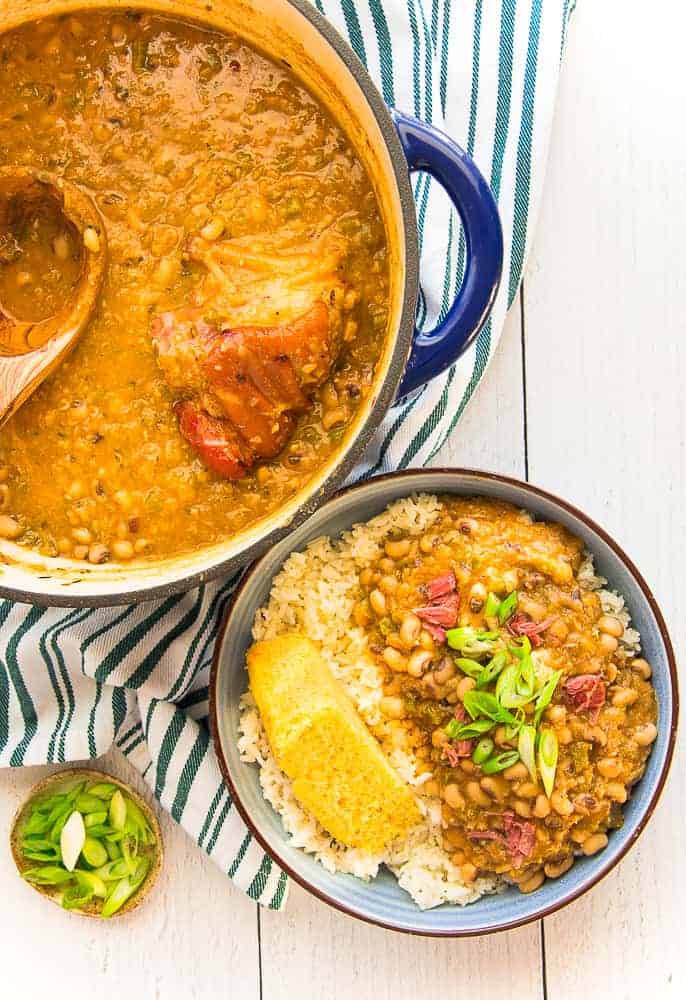
What are Black Eyed Peas?
Black eyed peas are a legume often referred to as cowpeas, though they are actually a subspecies of the cowpea. Some folks call them black eyed, black eye, or blackeye peas. I’m in the first camp. Tons of cultures worldwide consume this small, kidney-shaped bean, identifiable by the prominent black spot (or eye) found in its center.
Black-eyed peas have a muted, earthy flavor when eaten as is. They are very nutritious, too. The great George Washington Carver once encouraged farmers to sow the peas in their fields to replenish lost nutrients and provide a crop for them to consume high in calcium, protein, and fiber.
Where do they originate?
In my research, I could not track down a specific country of origin for the black-eyed pea. As I mentioned before, many countries include it in their diets.
Africans and Brazilians form a patty after mashing them, then fry those in dendê, or palm oil, or similar frying oil. Mediterranean and Middle Eastern cuisines serve them chilled in a light lemon vinaigrette. Asians, specifically Indians, simmer the peas in a spiced coconut curry sauce.
In the States, the most popular way to prepare black-eyed peas is with stewed and served with steamed white rice. I’m also a fan of serving them as fritters, though.
Are Black Eyed Peas and Rice Called Hoppin’ John?
Many people refer to black eyed peas and rice as hoppin’ John, but, as Amethyst Ganaway informs us in this Serious Eats article, hoppin’ John has an altogether different makeup and uses a different pea.
Hoppin’ John is made with field peas that are reddish-brown in color. And unlike our method of spooning the peas on a bed of white rice, the OG hoppin’ john is a mixture of rice and peas cooked together in one pot.
Amethyst explains that the black-eyed peas and rice dish was the result of The Great Migration. Black Americans couldn’t bring their ingredients with them up North so they tailored the foods they found in their new cities to their beloved dishes from back home.
Do I Have to Soak Black Eyed Peas Prior to Cooking Them?
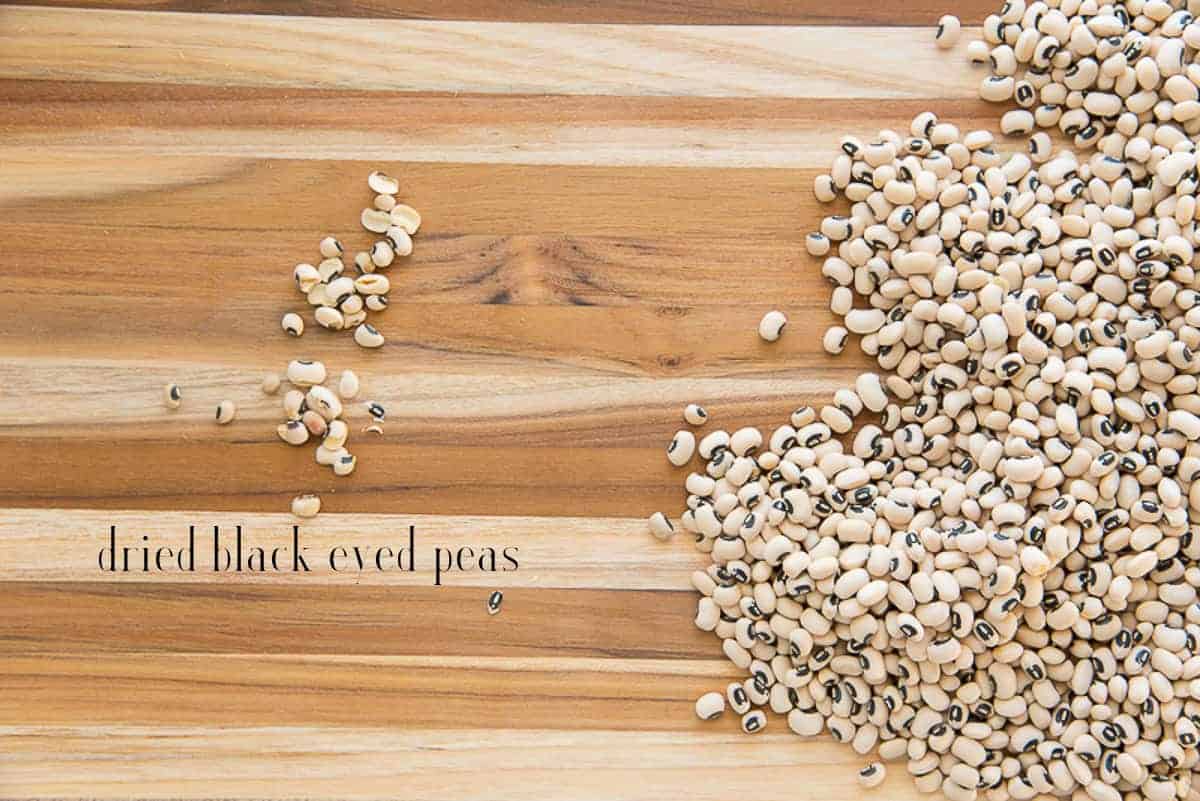
Dried black-eyed peas must be sorted and soaked before you cook them.
To sort black eyes peas, dump them out onto your countertop and pick through them to remove split, misshapen, or minuscule peas. You also want to get rid of stones or twigs that may have found their way into the bag during processing. Repeat this sorting process once or twice more, then discard any undesirables.
Why Do I Need to Soak the Peas?
Next, rinse the remaining peas under cold, running water. Dump them into a dutch oven and cover them with at least 6-inches of cold water and soak the peas for 2-3 hours.
Soaking beans helps reduce the cooking time by softening them. You extend your cooking time considerably if you don’t soak them because dried beans are literally rock hard. Soaking keeps you from having to babysit a pot of simmering peas.
If you want to soak the peas ahead of when you plan to cook them, place the dutch oven in the fridge for up to 24 hours. Change the soaking water every 24 hours to keep it giving the peas an off taste.
Cook the beans within 2 days of soaking. Alternatively, you can drain the peas after they soak for 3 hours and transfer them to a freezer storage bag. Freeze them for 3-4 months.
Is There a Way to Speed Up the Soaking Process?
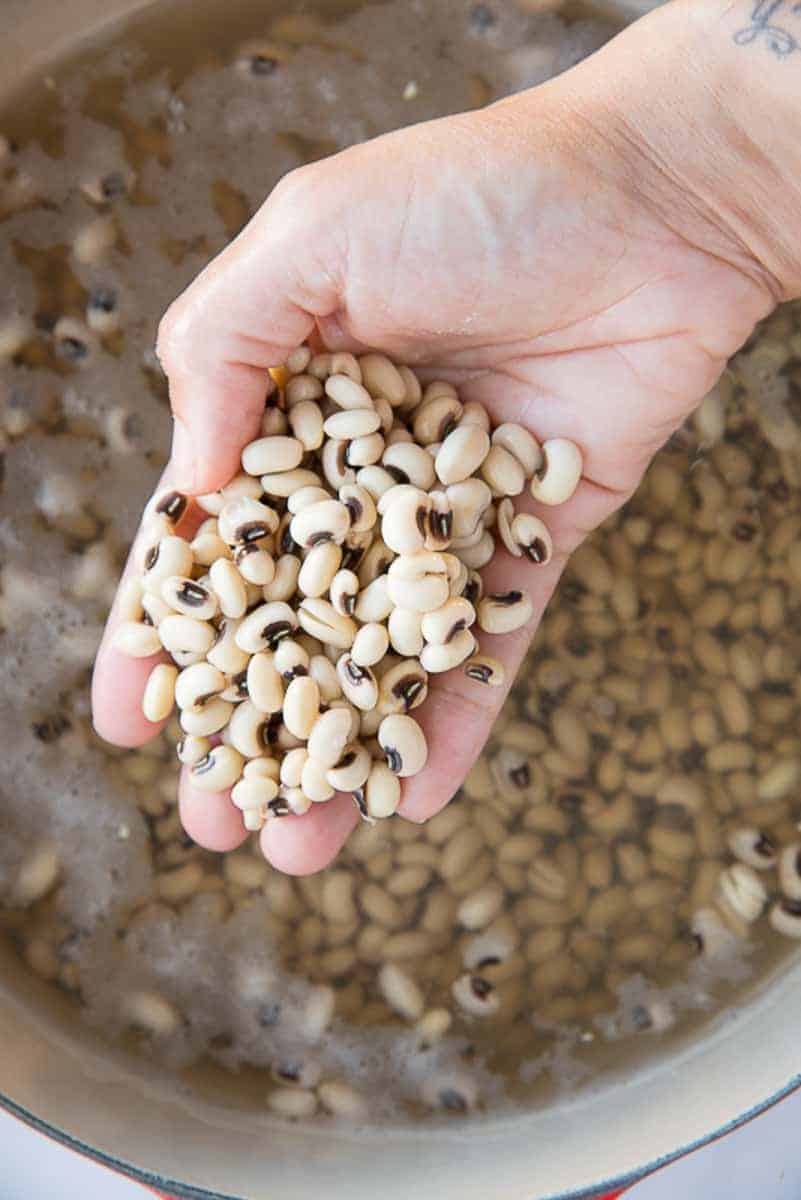
You can use a quick-soak method if you’re short on time. I often use this technique when I get a last minute craving for black eyed peas.
For the quick-soak method:
- Bring the peas up to a boil after rinsing them.
- Turn off the heat, cover the pot of peas, and allow them to sit in hot water for 1 hour.
- Drain them as use as your recipe instructs.
Do I Get Rid of the Cooking Liquid?
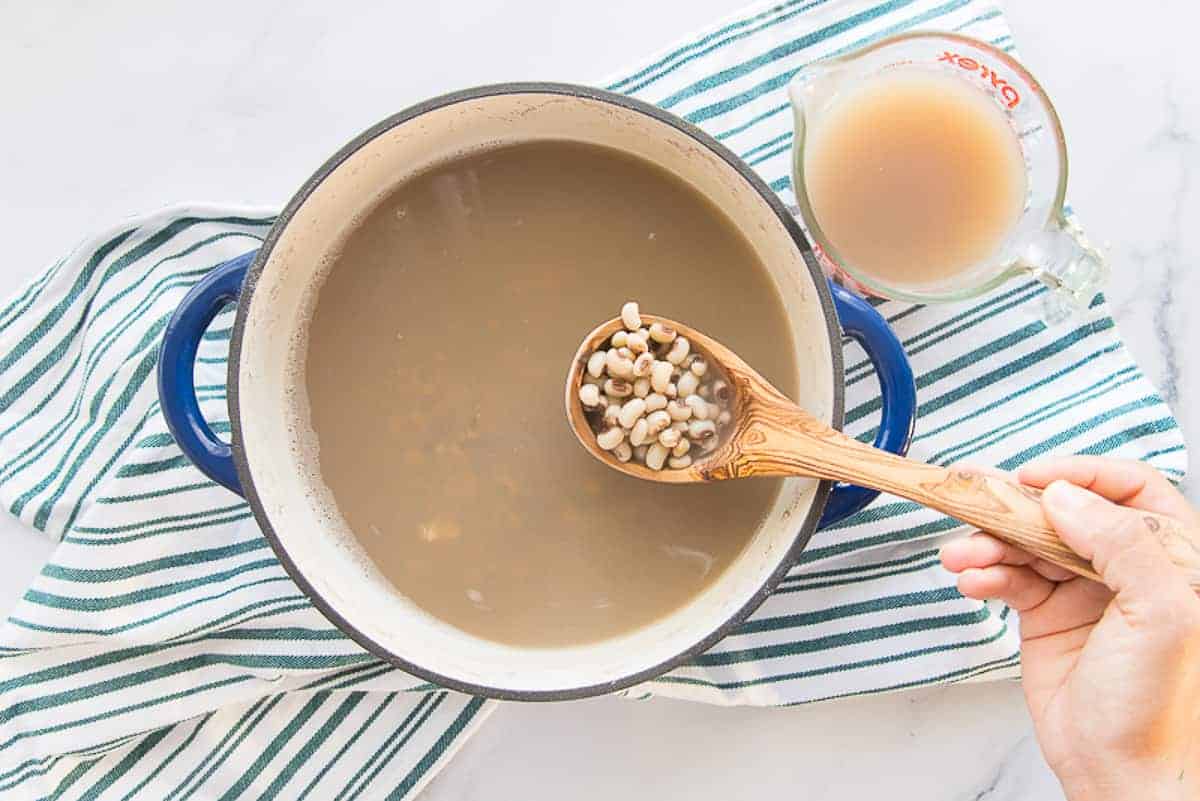
Drain off the soaking water once the peas are done soaking. Rinse them under cold water, then return them to the dutch oven.
Add cold water to the pot and bring the water up to a gentle simmer over medium-low heat. Gently simmer the peas for 20 minutes. Try to avoid boiling the peas, since that causes them to split later on. Simmering black eyed peas after soaking is another way to prevent rock-hard peas in your recipes.
Remove 2 cups of the cooking liquid from the pot after simmering the peas. Using the cooking liquid from your black eyed peas adds flavor and texture to your finished dish. Drain the rest of the liquid and rinse the peas again in cold water. This stops the cooking process and gets rid of excess starch from the bean’s exterior.
Can I Replace the Dried Black Eyed Peas with Canned?
You can substitute canned black eyed peas for the dried in this recipe since, sometimes, they’re more convenient.
To replace canned black eyed peas for dries, use the same amount of peas as the recipe calls for and omit the sorting, soaking, and parboiling steps.
Drain off the liquid in the can of peas and give the peas a rinse under cold running water and use them as follows.
What Ingredients Do I Need to Make Black Eyed Peas and Rice?
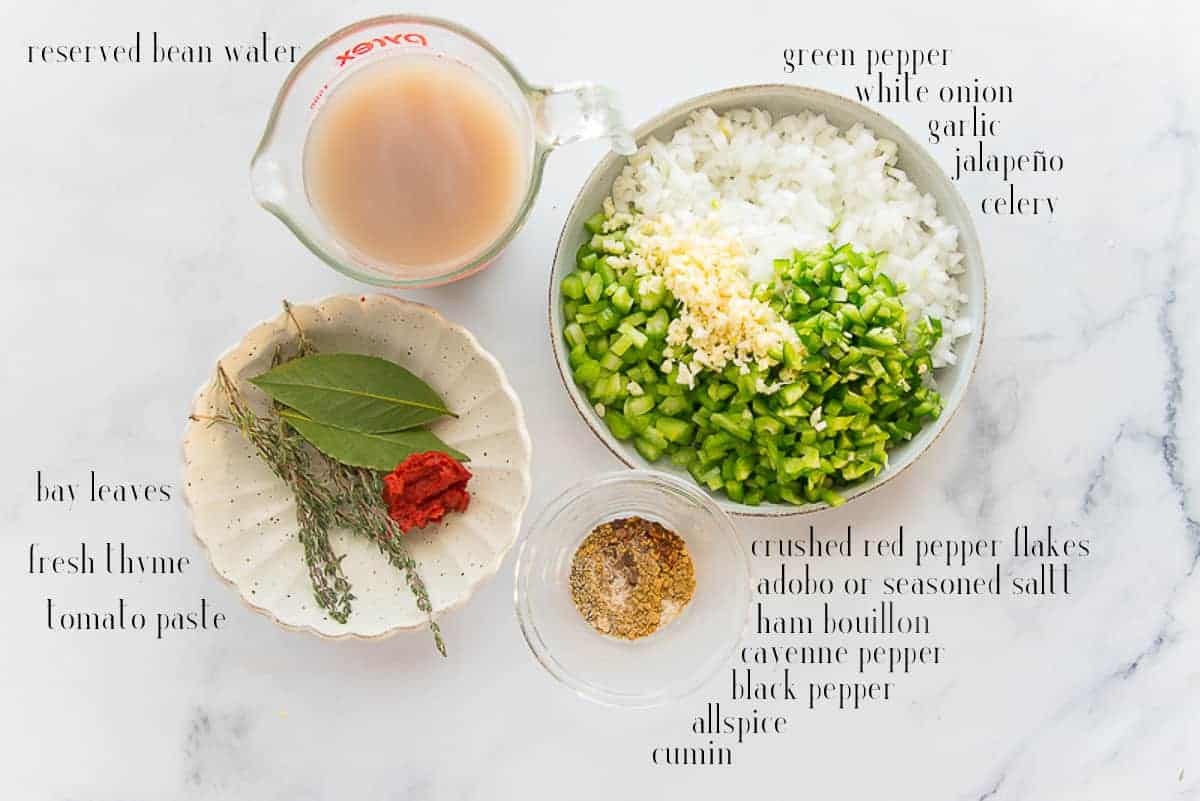
The black eyed peas are the main ingredient in black eyed peas and rice, but you also need white onion, celery, and green bell pepper, garlic, jalapeño (this is optional), fresh thyme, bay leaves, tomato paste, and a mix of spices to round out the seasonings.
Lastly, a ham hock and ham bouillon or stock for even more flavor.
What is the Holy Trinity?
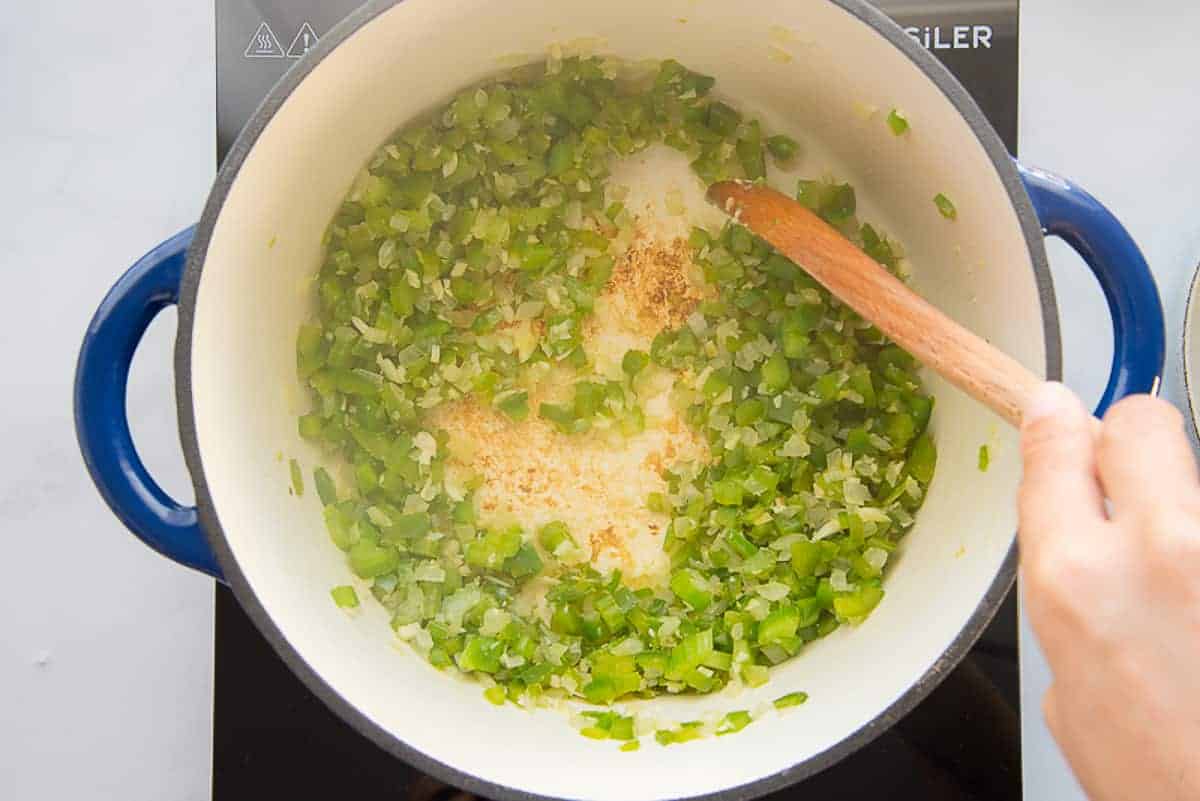
In Cajun and Louisiana cooking, the holy trinity is a flavoring base comprised of onion, green bell pepper, and celery. While this isn’t a Louisianan recipe per se, I always use this combo for my black eyed peas.
Heat a small amount of cooking oil in a dutch oven over medium heat. Add the holy trinity, the garlic, and the jalapeño pepper to the shimmering oil and sauté them for 2 minutes. Once the onions and peppers appear glossy, lower the temperature to medium-low and continue sautéing the mixture for 13 more minutes.
The goal here is to cook the aromatics down almost to a pulp without caramelizing or burning them. If the bottom of your pot gets darker than what you see above, reduce the temperature. You need to cook it for the full 15 minutes, so adjust the heat accordingly.
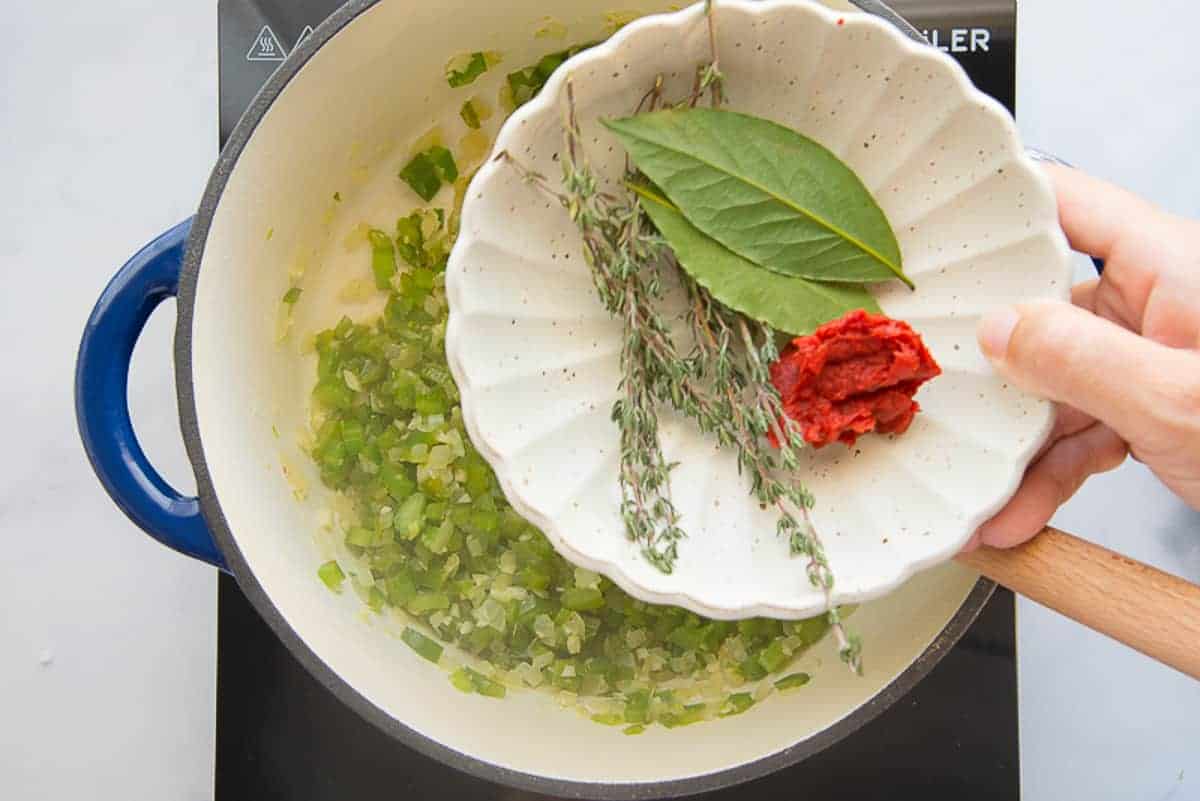
After 15 minutes, stir in the fresh herbs, tomato paste, and all of the spices. Stir these into the sautéed veggies until a thick paste forms, or for 1-2 minutes.
Can I Replace the Pork in This Recipe?
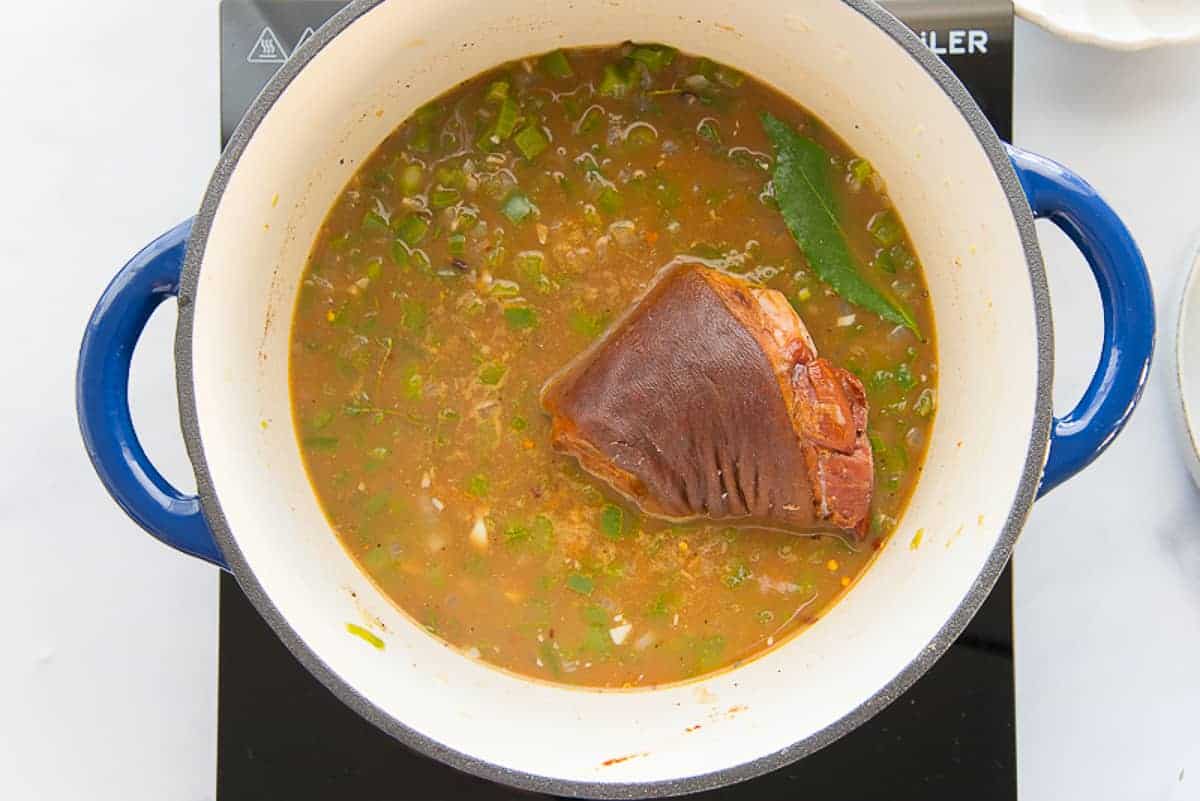
Next, pour in cold water, the reserved cooking liquid; then add the ham bouillon and the ham hock to the pot. Increase the heat to medium.
You can replace the ham hock and ham bouillon in this black eyed pea recipe for a smoked turkey wing (or neck) and turkey or chicken bouillon or stock.
Bring the liquid up to a gentle boil. As you stir, be sure to scrape the bottom of the pot to lift any stuck-on bits of food.
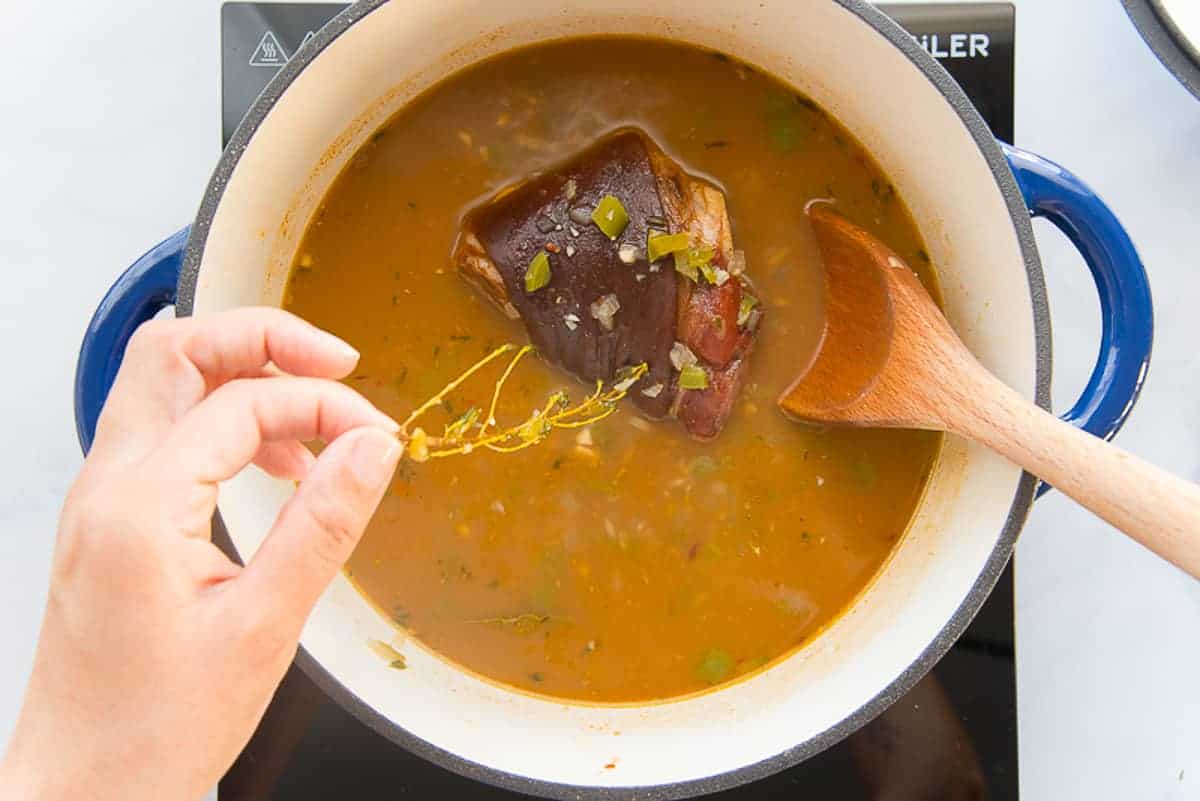
Once the liquid comes to a boil, reduce the heat to medium-low once again and cover the pot. Simmer the liquid for 10 minutes. This concentrates all of those flavors in the liquid, which we’ll later cook our black-eyed peas in.
After 10 minutes of simmering, fish out the bare stems of thyme. The thyme stems are easier to locate and remove now. Leave the bay leaves in as we’re going to use them as long as possible.
How Long Do Black Eyed Peas Have to Cook?
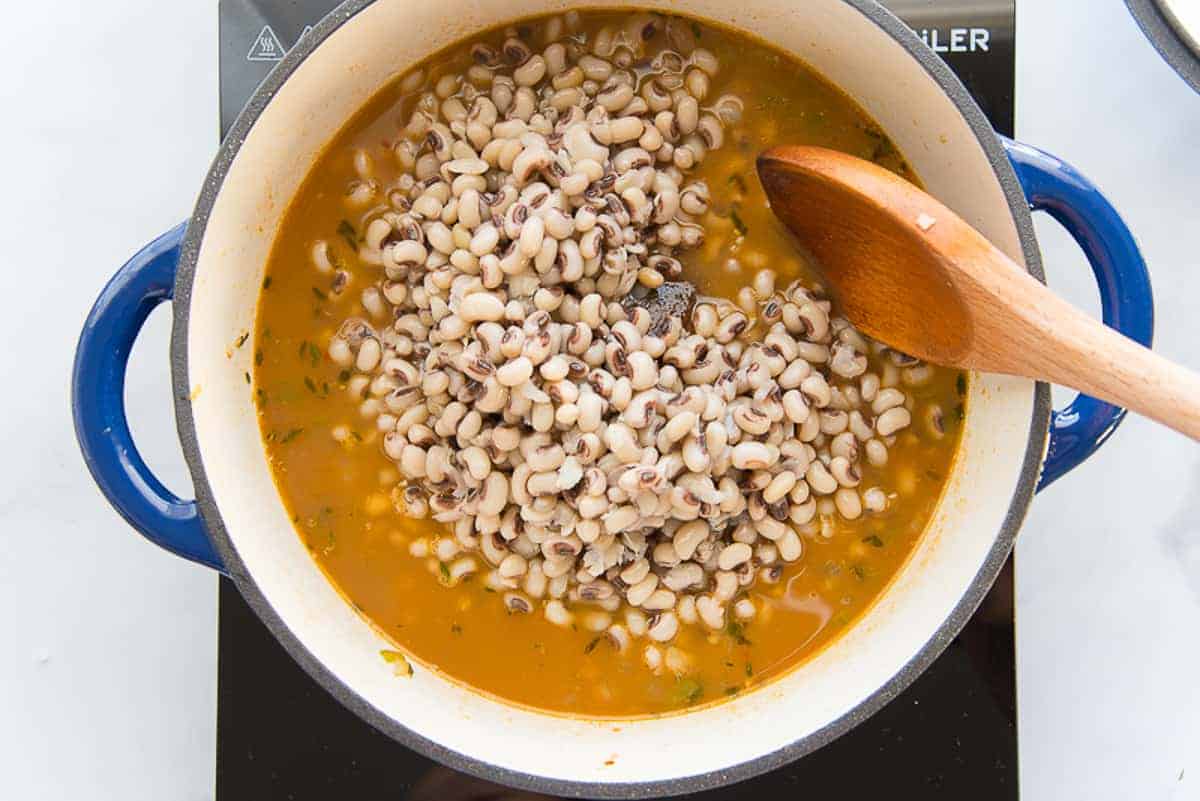 Stir the soaked peas into the flavorful broth.
Stir the soaked peas into the flavorful broth.
Bring the liquid up to a gentle simmer. Avoid boiling the black eyed peas as that will cause a lot of them to split. Minimal movement on the surface of the liquid is what you’re looking for. Once the liquid comes to the correct temperature, cover the pot.
Simmer the black eyed peas for 20-30 minutes, stirring them every so often to keep them from sticking to the bottom of the pot.
How Do I Thicken the Liquid?
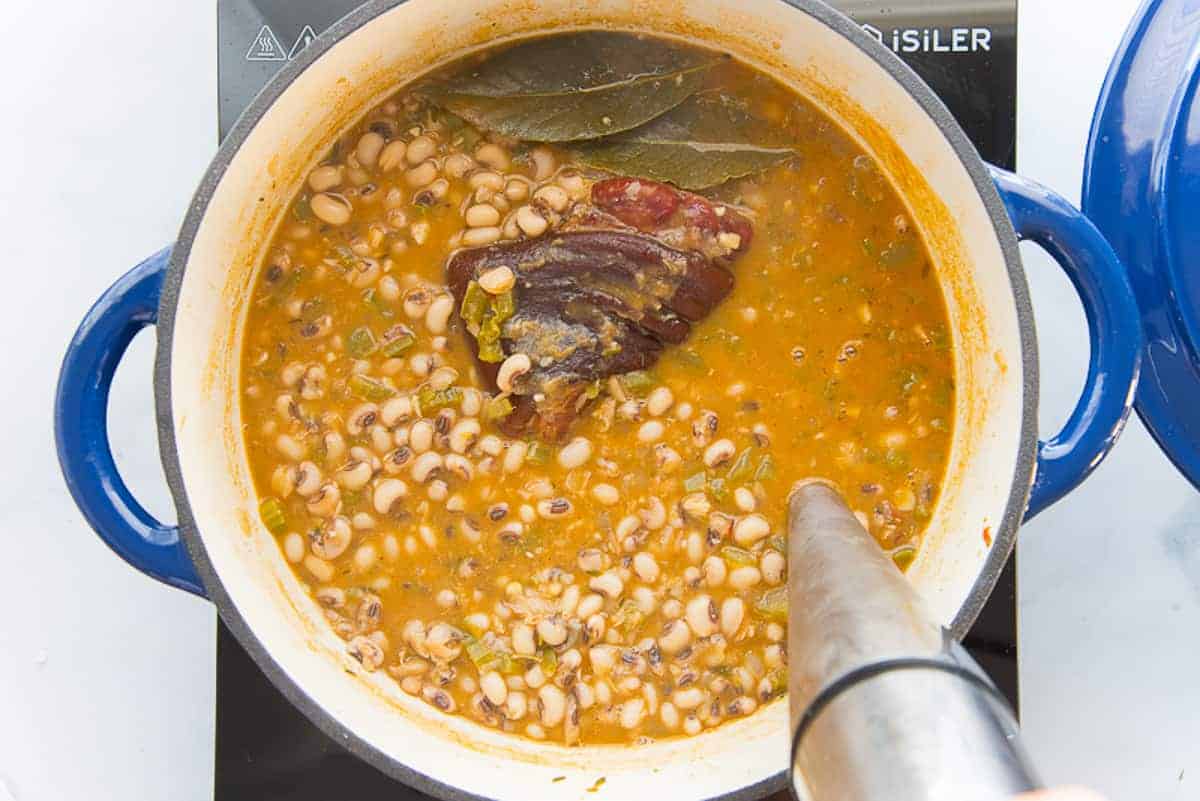
After 20 minutes of gentle cooking, taste a pea or two. The peas should have slight texture to them but shouldn’t be hard or crunchy. If they are, continue simmering them for another 10-15 minutes.
While the peas can be served as is, I prefer a slightly thick sauce for mine. To create a sauce for your black eyed peas use an immersion blender to blend just a small amount of the peas in the pot. I eyeball a quadrant of the pot and blend just that amount with my immersion blender.
If you prefer a thinner broth for your peas, you can just skip the blending altogether. Taste the broth with a couple of peas and adjust the seasonings to taste by adding a little more adobo or seasoned salt.
Can I Use this Method with Other Legumes?
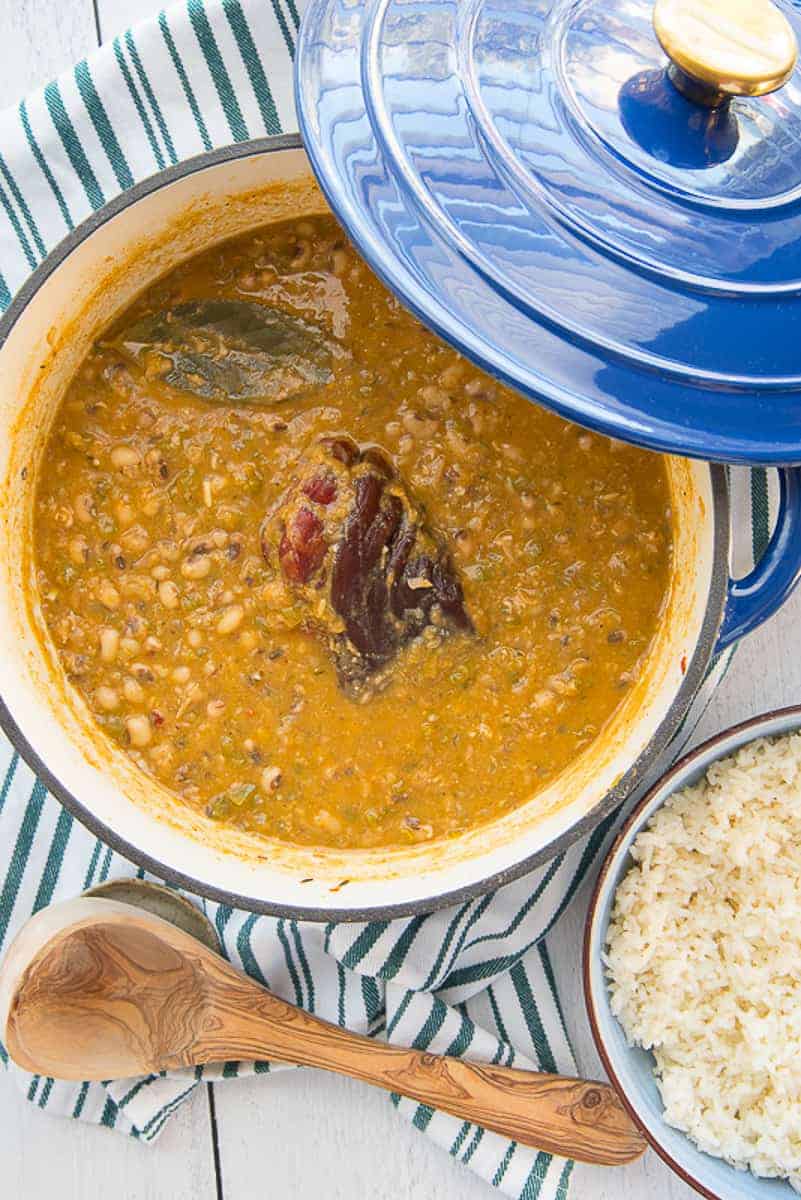
You can use this entire process- from sorting to cooking- with any dry beans, except lentils, which cook faster.
If you prefer more Hispanic flavors, check out my Habichuelas Guisadas recipe.
What Do I Serve Black Eyed Peas With?
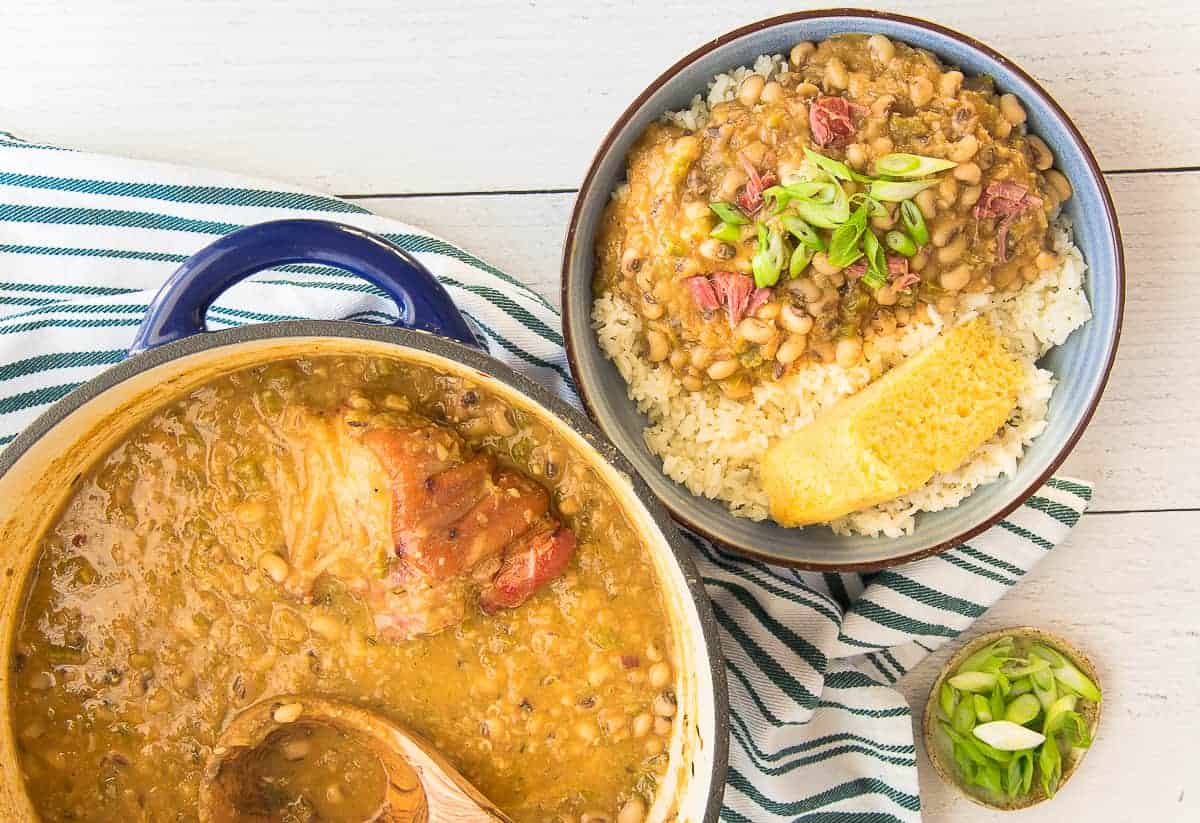
The traditional way to serve black-eyed peas is spooned over Steamed White Rice with a generous slice of cornbread.
I serve the dish as a main course after cutting the meat from the hocks. Even without the ham hocks, the peas are substantial enough to serve as an entree.
How Do I Store Leftovers?
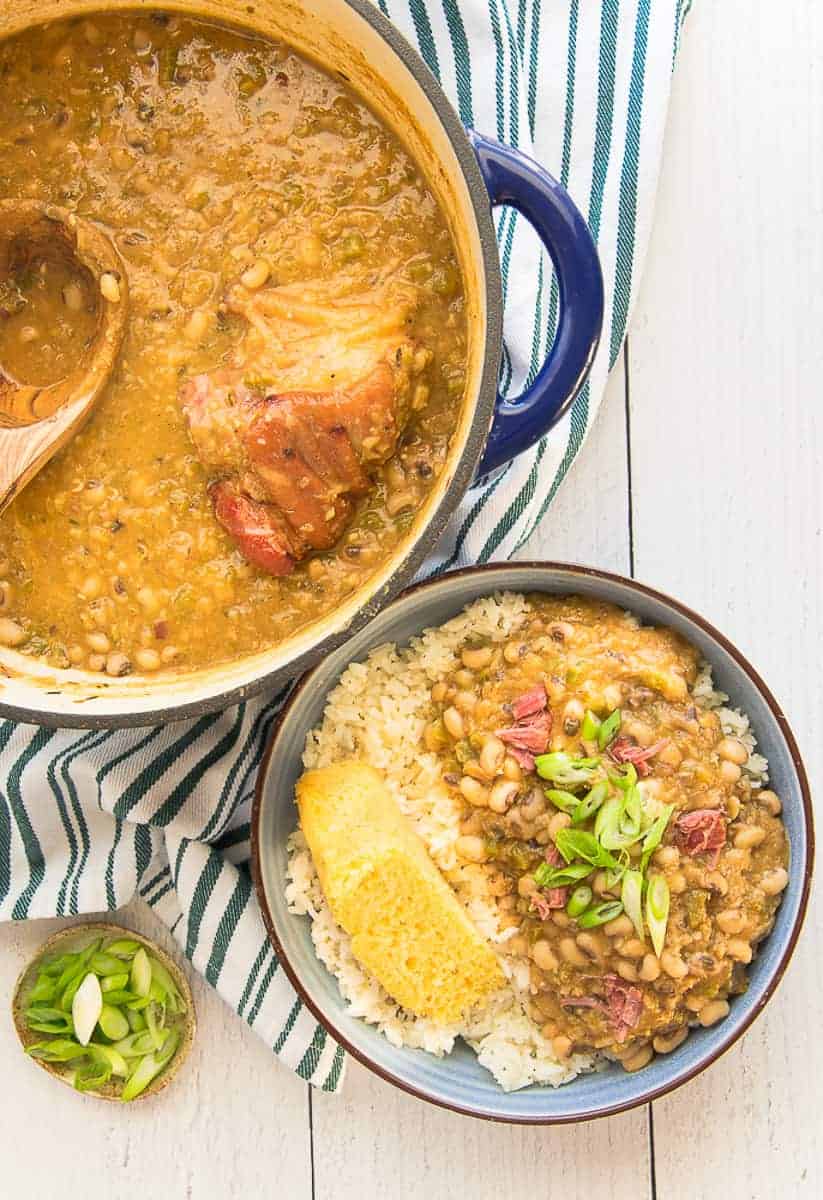
To store leftover black eyed peas and rice, allow the peas to cool, then transfer them to a food storage container and store them in the fridge for up to 3 days.
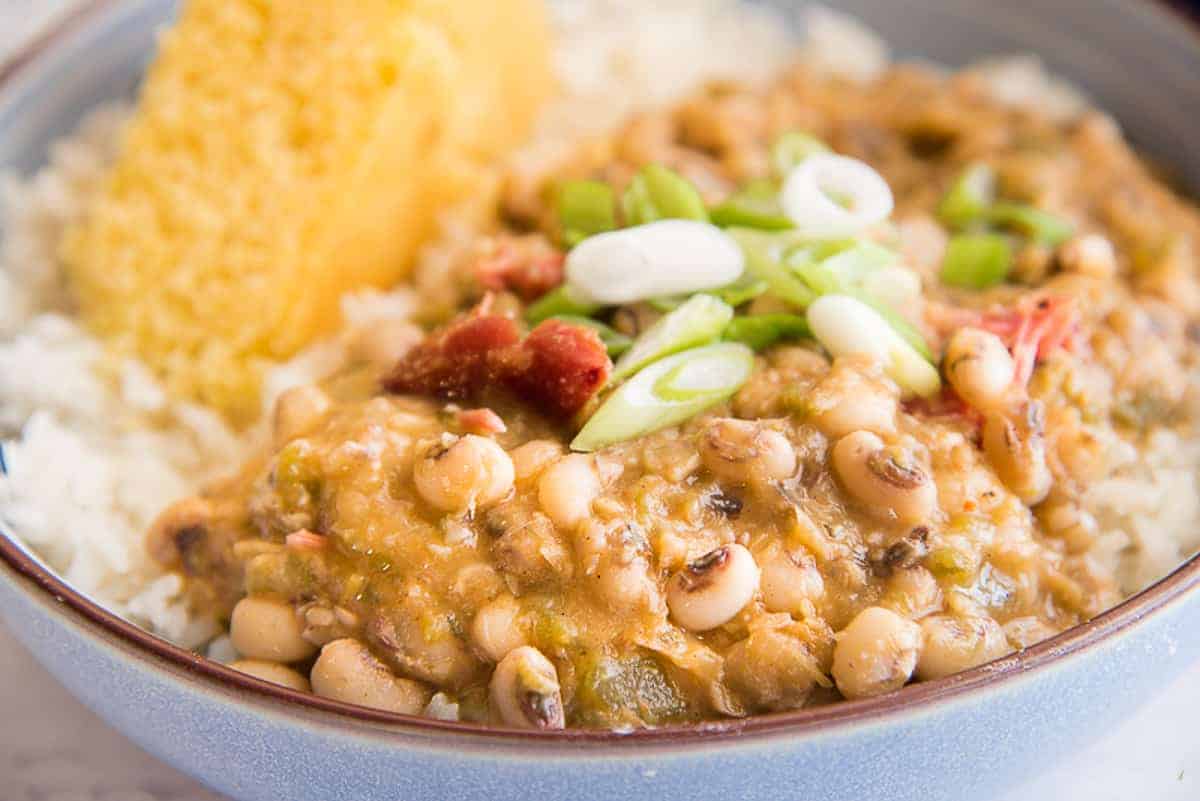
To reheat black eyed peas and rice, microwave them on high for 1 1/2 to 2 minutes, stirring halfway through heating.
Can I Freeze the Cooked Black Eyed Peas?
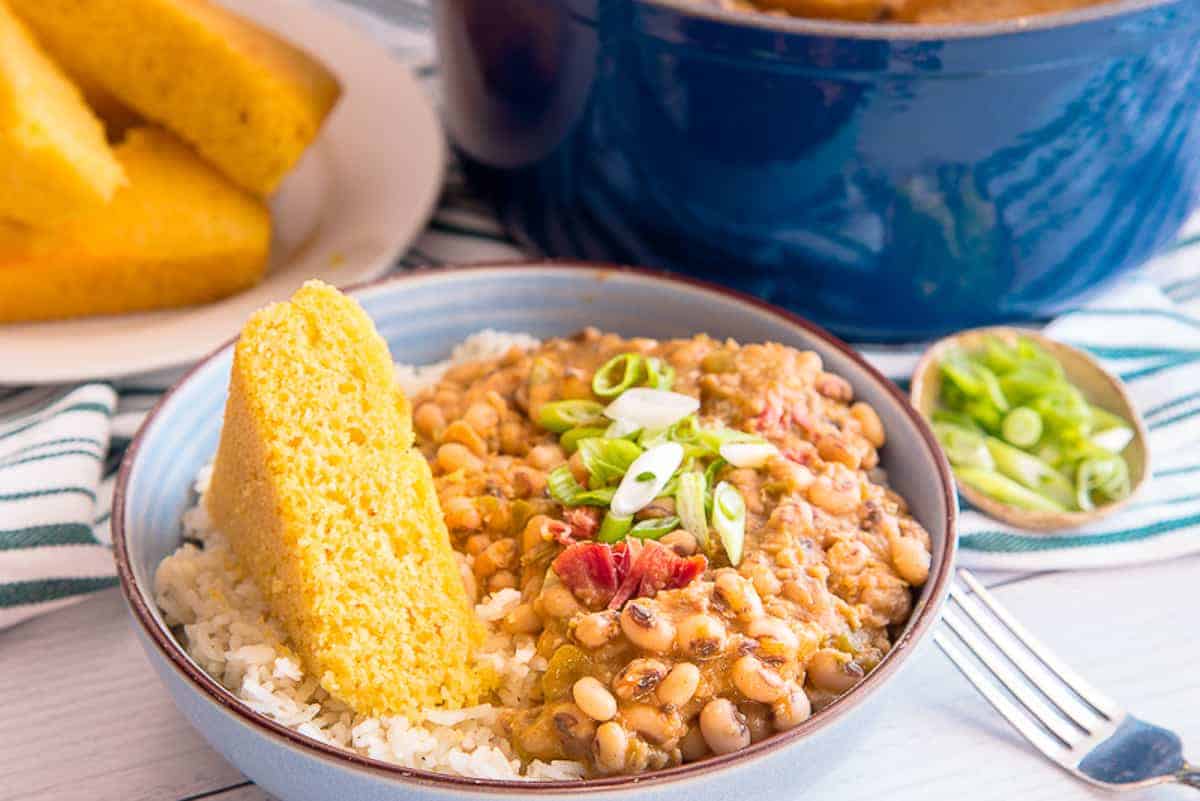
Freeze the black eyed peas after cooling completely and transferring them to a freezer storage bag. They freeze well for up to 4 months.
Thaw the peas in the fridge and reheat them in the microwave or on the stove top with a small amount of broth or water stirred in.
As we approach the new year and celebrate all of the accomplishments and advancements African Americans have contributed to our nation, I do hope you cultivate new, or reinvigorate old, traditions with your family. My family and I wish you the happiest and healthiest in the future. Be sure to pin and share this recipe so your friends and family can, hopefully, usher in wealth and prosperity too!
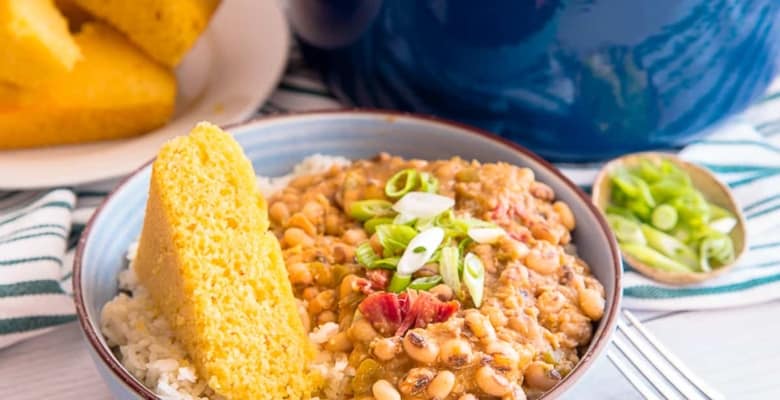
Black Eyed Peas with Rice
at Sense & EdibilityEquipment
- 4-quart dutch oven
Ingredients
To Soak the Black Eyed Peas (begin 3 hours ahead)
- 1 pound (455 grams) dried black eyed peas sorted and rinsed
- 6 cups (1 1/2 liters) cold water
To Cook the Black Eyed Peas
- 1 tablespoon (15 grams) lard or vegetable oil
- 2 stalks celery trimmed and diced (3/4 cup or 128 grams)
- 1 small white onion peeled and diced (1 cup or 125 grams)
- 1 medium green bell pepper seeded and diced (1 cup or 120 grams)
- 1 medium jalapeño pepper seeded and minced (2 tablespoons or 30 grams), optional
- 6 cloves garlic peeled and minced (2 tablespoons or 30 grams)
- 2 large bay leaves
- 4 sprigs thyme
- 1 heaping tablespoon (17 grams) tomato paste
- 1 tablespoon (18 grams) adobo (or seasoned salt), plus more to taste
- 2 teaspoons (4 grams) ground cumin
- 1/2 teaspoon black pepper
- 1/4 teaspoon ground allspice optional
- 1/4 teaspoon cayenne pepper optional
- 2 cups (500 milliliters) cold water
- 1 1- 1 1/2 pound (455-685 grams) ham hock or smoked turkey wing
- 1 teaspoon (6 grams) ham bouillon (or chicken), optional
To Serve
- steamed white rice
- green onions sliced on a diagonal
Instructions
Soak and Soften the Black Eyed Peas
- Place the sorted and rinsed black eyed peas into the dutch oven and cover them with the cold water. Soak the peas on the countertop for 2-3 hours.
- Once the peas have soaked, drain off the soaking water. Give them a quick rinse under cold water before returning them to the dutch oven.
- Add 6 cups of cold water to the pot, then bring the water up to a gentle simmer over medium-low heat. Gently simmer the peas for 20 minutes. To prevent excess splitting of the peas, don't allow the water to boil.
- After simmering the peas, use a measuring cup or spoon to remove 2 cups of the cooking liquid from the pot. Once you've removed the cooking liquid, drain the rest away, then rinse the peas again in cold water to stop the cooking process and remove excess starch from the bean's exterior.
Cook the Black Eyed Peas
- In a dutch oven over medium heat, heat the lard until it melts and begins to shimmer in the pot. Add the onion, green bell pepper, celery, jalapeño pepper, and garlic to the pot and sauté them for 2 minutes.
- Once the onions and peppers appear glossy, lower the temperature to medium-low and continue sautéing the mixture for 13 minutes.Cook the aromatics down to a pulp without allowing them to caramelize or burn them. If mixture on the bottom of your pot begins to turn dark brown, reduce the temperature and add a 1/4 cup of cold water to slow down the browning. The only color you want is a golden brown on the bottom of the pot.This mixture needs to cook it for the full 15 minutes, so adjust the heat accordingly.
- After 13 minutes, stir in the adobo (or seasoned salt), bay leaves, thyme, tomato paste, cumin, black pepper, allspice, and cayenne. Stir these into the sautéed veggies and cook until a thick paste forms, or for 1-2 minutes.
- Next, add the cold water, the reserved cooking liquid, ham hock, and the ham bouillon to the pot. Increase the heat to medium. Bring the liquid up to a gentle boil. Scrape the bottom of the pot with your spoon to lift any stuck-on bits of food.
Simmer, Then Thicken the Black Eyed Peas
- Once the liquid comes to a boil, reduce the heat to medium-low once again and cover the pot. Simmer the liquid for 10 minutes to concentrate all of the flavors in the liquid.
- After 10 minutes of simmering, remove the thyme sprigs. Gently stir the softened black-eyed peas into the pot.
- Bring the liquid up to a gentle simmer. Avoid boiling the peas as that will cause a lot of them to split. Once the liquid comes to the correct temperature, cover the pot.Cook the peas for 20-30 minutes, gently stirring them every so often to keep them from sticking to the bottom of the pot.
- After 20 minutes of gentle cooking, taste for doneness. The peas should have slight texture to them but shouldn't be hard or crunchy. If they are, continue simmering them for another 10-15 minutes.
- To thicken the sauce, black-eyed peas use an immersion blender to blend just a small amount of the peas in the pot. If you prefer a thinner broth for your peas, you can just skip the blending. Once you have your preferred consistency, taste the broth with a couple of peas and adjust the seasonings to taste by adding a little more adobo or seasoned salt.
- Remove the ham hock and bay leaves from the pot. Shred or cut the meat from the hock and return the meat to the pot. Discard the bone (or save to use in soup) and the leaves. Serve the black-eyed peas spooned over Steamed White Rice and garnished with sliced green onions.
Notes
Swaps and Substitutions:
- Replace the 2 cups of cold water with ham or turkey stock.
- Omit the jalapeños for less spice.
Quick Soak Method (for the black eyed peas):
- Add the peas to the dutch oven and cover them with the cold water.
- Bring the water to a boil over medium heat.
- Once the water begins to boil, turn off the heat, cover the pot of peas, and allow them to soak for 1 hour on the stovetop.
- Drain the peas and use accordingly.
To Slow Soak (or Freeze) Uncooked Peas or Beans:
- Cover the peas with water, then place the dutch oven in the refrigerator for 2 days.
- Change the soaking water every 24 hours.
- Be sure to cook the beans within 2 days of soaking.
-
Alternatively, drain the soaked peas and transfer them to a freezer storage bag.
Freeze them for 3-4 months.
To Use Canned Black Eyed Peas:
- Replace the dried peas with 4 cans of black eyed peas.
- Drain the liquid from the can of peas, then give the peas a rinse under cold running water.
- Use as instructed adding 2 cups of water or stock to the recipe to compensate for the lack of reserved bean water.
To Store Leftover Black Eyed Peas:
- Cool the black-eyed peas completely.
- Transfer them to a food storage container and store them in the fridge for 3-5 days.
To Freeze Cooked Black Eyed Peas:
- Transfer the peas to a freezer storage bag and freeze them for up to 4 months.
- Thaw the peas in the refrigerator before reheating them in the microwave or on the stove top with a small amount of broth or water stirred in.








I had to let you know I made your black eyed peas for our New Year’s Day meal and they were scrumptious! Everybody went back for seconds!
Aww, I love that so much, Jazz. Happy New Year!
These black-eyed peas are super flavorful. I served them alongside southern fried chicken and the suggested white rice and cornbread. I couldn’t get enough!
That sounds like an amazing meal! So glad you enjoyed it!
I love black eyed peas! Very underrated, I make them all the time, not just for New Year’s. I love to see the different recipe variations. This is my first time trying them partially blended with an immersion blender. I do this with my red beans. Definitely love the heat from the jalapeno. It’s a must for me! Great recipe, thank you for sharing.
My pleasure, Krysten! Thanks for trying and commenting on it!
I just copied this recipe. Sounds almost exactly the way my grandmother (1913 – 1994) cooked them. Sadly, as a child, I didn’t pay attention and miss so much of her delicious food. (Ever heard of gumbo file’? It was my job as a child to sprinkle the file’ powder on top! LOL). Anyway, I just copied your recipe for this New Year Day 2024. FWIW, I’m not part of the Black culture but definitely from the deep South. Lots of cajun influence in our wonderful family recipes Thank you for sharing.
Yes, I use gumbo filé in my gumbo to thicken it a bit. As I mentioned, this is a very popular recipe throughout the Southern states and is very much a sacred tradition in the Black community. I hope you enjoy this recipe as much as I do!
They look absolutely delicious! Thanks for all the amazing info about black-eyed beans! I’ve never actually had them which is crazy to me, I can’t wait to try them next week!
Let me know what you think!
This is total comfort food! Your recipe is well written, informative and so helpful. Thanks for sharing!
My pleasure!